/!\
/!\
Une plainte en diffamation a été engagée à ma demande auprès
du procureur de la république concernant l'auteur de ce blog : http://leveil2011.syl20jonathan.net/?p=5377
En effet, en aucun cas je ne soutiens, confirme et valide de
tels propos obscurantistes.
Je rappelle que :
"toutes les images et textes de ce site sont protégés
par les lois internationales sur le copyright
et ne peuvent être utilisés, sous
quelque forme que ce soit, sans une autorisation écrite de son auteur".A libel suit was brought to my request with the offers of the Republic
about the author of this blog : http://leveil2011.syl20jonathan.net/?p=5377
Indeed, in any case I do not support, confirm and validate such remarks obscurantist.
I recall that : "All images and text from my site are protected by international law
copyright and may not be used in any form whatsoever without
written permission of its author".
C 2010 X1 ELENIN

Animation : 2X(4X300)s
C 2010 X1 ELENIN rémanence / débris 07H16.26 +30°06.49 le 20111024 à 02H40 TU m1 : 7.35 MPC UA : 0.25
MAK. 90/470 RUBINAR ATICK 314L+ 2X(4X300)s, Bin 2x2, avec autoguidage 2 axes (SBIG ST7XME-d)
CCD -10°C, 5.7"/pix, champ +/-60' X 45’, sans filtre
pas de dark, pas d'offset, pas de plu PRISMV8, DDP, GIMP, recalage, speed : 7.8"/min
Seeing 3/5, Vent moyen N/E, Lune : 67°, M.d’air : 1.17, Seine et Marne, FRANCE

Animation : 2X(4X300)s Median 3x3 en ligne

Animation : 3X(3X300)s
C 2010 X1 ELENIN rémanence / débris 07H16.26 +30°06.49 le 20111024 à 02H40 TU m1 : 7.35 MPC UA : 0.25
MAK. 90/470 RUBINAR ATICK 314L+ 3X(3X300)s, Bin 2x2, avec autoguidage 2 axes (SBIG ST7XME-d)
CCD -10°C, 5.7"/pix, champ +/-60' X 45’, sans filtre
pas de dark, pas d'offset, pas de plu PRISMV8, DDP, GIMP, recalage, speed : 7.8"/min
Seeing 3/5, Vent moyen N/E, Lune : 67°, M.d’air : 1.17, Seine et Marne, FRANCE
COMET C/2010 X1 (ELENIN)Giovanni Sostero, Ernesto Guido, and Nick Howes
report on their attemptsto image comet C/2010 X1 (cf. IAUC 9226) after its
solar conjunction, usingseveral robotic scopes that were operating under
excellent sky conditions inNew Mexico and at Mauna Kea on Oct. 9.5 and 10.6
UT, yielding no sign of thecomet at low altitude. Several stacked exposures
taken on Oct. 10.6 with the2.0-m f/10 Ritchey-Chretien "Faulkes Telescope
North" show no trace of thecomet within the 10' x 10' field-of-view centered
on the comet's ephemeris(limiting magnitude around 20.5). But after stacking
unfiltered CCD imagestaken in moonlight by Guido, Sostero, and Howes on Oct.
21.38 and 21.48 UTremotely using the GRAS 0.1-m f/5 APO refractor at the
Mayhill station in NewMexico (field-of-view 3.9 deg x 2.6 deg; scale 3".5
pixels), they foundsomething moving on the sky background via blinking the
two sets that wereseparated by about 2 hours: an extremely faint and diffuse
blob of tentativesize 14' x 8' (elongated toward p.a. 300 deg) with no
obvious condensationthat is close to the ephemeris position (roughly 3'.5
east-southeast of theprediction), moving apparently with the comet's
motion.Guido, Sostero, and Howes confirmed their detection of the
comet's"cloud" in observations obtained on Oct. 23.4 with the same
refractor, thecloud being roughly 40' long with a 6' extension near the
expected positionof the comet. Images are posted at website URLs http://bit.ly/q5QCM7 andhttp://bit.ly/pXxtpY (with an "X"
marking the the ephemeris position inthe second image); an animation showing
the motion with respect to theX-marked movement of the expected comet's
position is shown at website URLhttp://bit.ly/qOx8oF. Sostero, Guido, and Howes then
subtracted the fieldstars to obtain the images posted at URL http://tinyurl.com/64fbkcb.
Theynote that the sunward part of the "cometary cloud" appears much
sharpercompared to the anti-solar direction; the diffuse shape of the comet
appearsto be somehow "conical", about 1.5 deg long overall, with a
maximumthickness of about 10' on the side toward the solar direction, and
the ovalshape of the "cometary cloud" then thins significantly tailward
(p.a. about300 deg). The "brightest" part of this extremely faint blob of
light islocated about 4'.3 in p.a. 77 deg (east-northeast) when compared to
thenominal position of the MPC ephemeris.Z. Sekanina, Jet Propulsion
Laboratory, writes that the deep CCD imagesof the disintegrated comet taken
in the past few days, especially the high-quality processed image from Oct.
23.37 UT by E. Guido et al., show enoughdetail to allow simple modeling and
a preliminary interpretation of thesurviving tail. The sharp cigar-shaped
trail near the southern end of thisdust-ejecta cloud points at position
angle 290 +/- 1 deg, which, interpretedas a synchrone, implies a fairly
brief dust-emission event centered on Aug. 16+/- 4 days, in fair agreement
with a rather sharply peaked light curve onAug. 13-14 and with Mattiazzi's
report of the comet's notable fading from Aug.17 on (CBET 2801). Despite the
near-zero inclination of the comet's orbitalplane to the ecliptic, the
geometry from the earth has been relativelyfavorable. Because of the small
geocentric distance, the earth was on theAug. 23 almost 7 deg below the
orbit plane, when this picture was taken, andsince the sheet of dust in the
plane was spreading toward the earth, itprojected essentially to the north
of the trail in an approximately 160-deg-wide fan. The prolonged radius
vector was directed at p.a. 277 deg and thusmade an angle of 13 deg with the
sharp trail.Because of their fan-like distribution in the orbit plane, the
imageshows not only the ejecta from the first half of August, but from the
comet'sentire active period, starting far from the sun on the way to
perihelion.(Comets arriving from the Oort cloud are generally known to be
considerablyactive at large heliocentric distances on their way in; C/2010
X1 is one suchexample.) Because the bright tip of the cigar-shaped trail
lies on the line-of-variation, it apparently represents the location of the
most sizable debrisejected during the mid-August dust-emission event;
relative to the ephemerisposition, the perihelion time was late by some 0.06
day (Sept. 10.79 insteadof 10.73 TT), and this deceleration is equivalent to
a sudden change in theorbital velocity of more than 50 m/s, primarily in the
direction away fromthe sun. Whereas the comet's orbital motion may have
non-gravitationallydecelerated even before the mid-August event (though not
enough to detectcomputationally), the bulk of the effect should be due to
the evolution inthe past 10 weeks or so. Since this velocity change is too
high for fragmentsseveral meters across or larger, they must have been
short-lived (like in thecase of C/1999 S4; e.g., Weaver et al. 2001, Science
292, 1329) and soon musthave given birth to ever smaller fragments in a
cascading fashion. Thelargest debris surviving to date is perhaps in the
centimeter range.The trail's total length, which must of course be reckoned
from thebright tip of the trail along p.a. 290 deg, is from the image
conservativelyestimated at 50 arcmin -- implying a peak acceleration by
solar radiationpressure on the particles at the anti-solar end of about
0.0035 the solargravitational attraction, and their typical diameter for an
assumed bulkdensity of 1 g/cm^3 at 0.3 mm; these are the smallest particles
that we seein the trail. The part of the feature on the sunward side of the
bright tip-- technically an anti-tail -- consists of dust ejected from the
comet longbefore it disintegrated; the lengths of the anti-tail and the rest
of the tailin the directions from the east up to the west-northwest (but not
includingthe trail) must be reckoned from the comet's ephemeris position.
Indeed, thecloud to the east of the ephemeris position is seen to have a
fairly sharpsouthern edge and to emerge from this location. An imaginary
boundary betweenthe sharp trail and the anti-tail, in position angle 20 deg
(normal to thetrail), is populated by particles ejected from the comet more
than 200 daysbefore perihelion, back in January 2011; the feature can in
this direction befollowed for some 10 arcmin, where the smallest particles
are about 0.6 mm indiameter. The particles in the anti-tail itself may have
been ejected as longas several years ago, at distances of about 10 AU from
the sun or more -- andat a distance of about 25 arcmin, at the end of the
anti-tail, their minimumdiameter could easily exceed 1 mm. The uncertainty
is aggravated by theejection velocity, especially its normal component,
because of the near-edge-onviewing: even if it does not exceed 1 m/s, its
integrated effect may amountto a few arcmin in the image. The same effect is
also responsible for much ofthe minor extension of the dust cloud to the
south of the sharp trail.The entire cloud has slowly rotated clockwise and,
in the coming weeks,the position angle of the sharp trail and its length (in
units of the lengthon Oct. 23.37) should be as follows (at 0h ET): 2011 Oct.
26, 283 deg, 1.22;Nov. 5, 267 deg, 1.51; Nov. 15, 260 deg, 1.36; Nov. 25,
256 deg, 1.14; Dec. 5,254 deg, 0.95. Because of the continuing expansion in
space and theincreasing heliocentric and geocentric distances, the cloud
will necessarilybe fading and may not be observed until December. On the
other hand, becausethe earth's cometocentric latitude will gradually be
decreasing, the cloudwill be getting narrower, which will lead to a higher
optical depth. By theend of October, the anti-tail will disappear because of
the changing geometry,and the position of the early ejecta will gradually
fold toward the sharptrail, extending only slightly to the north of it. The
tip of the sharp trailshould then be at the very sunward end of the whole
feature.The long survival of the dust-ejecta cloud of C/2010 X1 is not
surprising,and it compares favorably with a number of similar instances in
the past; e.g.,the surviving tail of comet C/1925 X1 (Ensor) was
photographed in Bergedorfuntil 72 days after the time of disinegration (see
Sekanina 1984, Icarus 58,81). The amount of the dust ejecta in the cloud of
C/2010 X1 cannot bedetermined because of the lack of photometry. A very
crude estimate of thetotal cross-sectional area of the dust particles is
only provided by thevisual magnitude 10.2 that was estimated by J. J.
Gonzalez on Oct. 21; theresult is about 480 km^2. The mass of the cloud
comes out to be on the orderof 10^(12) grams.

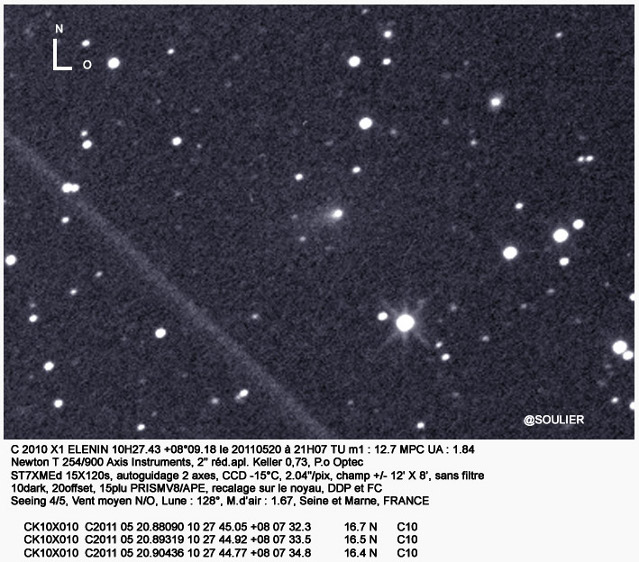

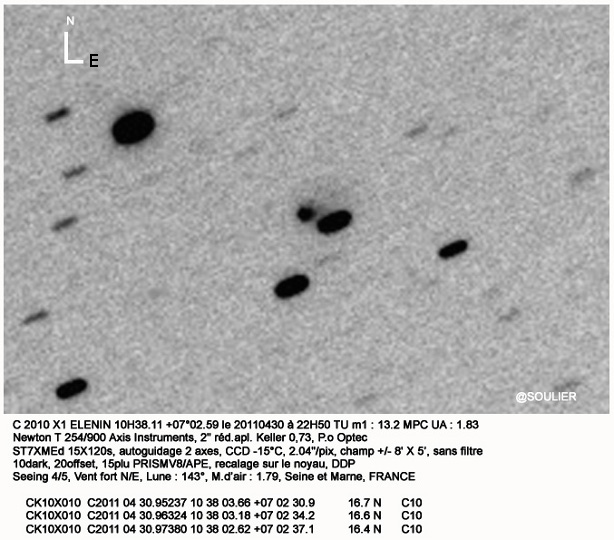


Speed : 0.724"/min, Diam. com : +/- 36"
Mesures du 2011.04.10
NET USNO-B1.0
CK10X010 C2011 04 10.03133 11 00 06.77 +04 47
03.2 16.9
N C10
CK10X010 C2011 04 10.03725 11 00 06.27 +04 47
06.2 16.7
N C10
CK10X010 C2011 04 10.04177 11 00 05.96 +04 47
07.9 16.6
N C10

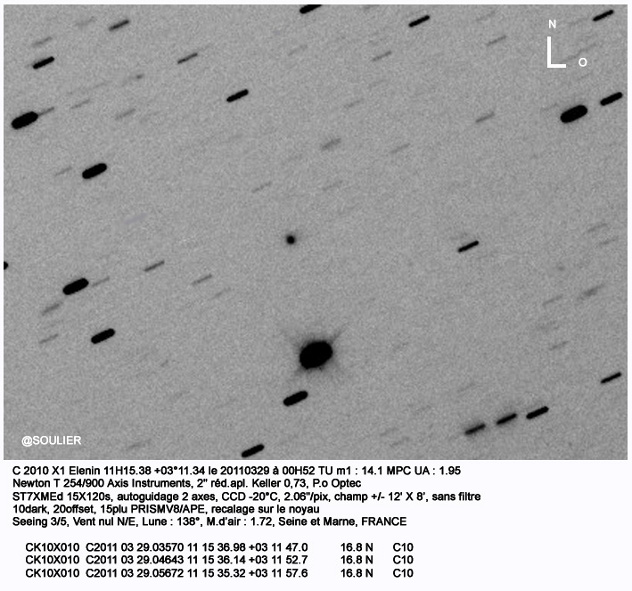




Animation 5x(3x120s) le
20110305

Animation 5x(3X120s) le 20110303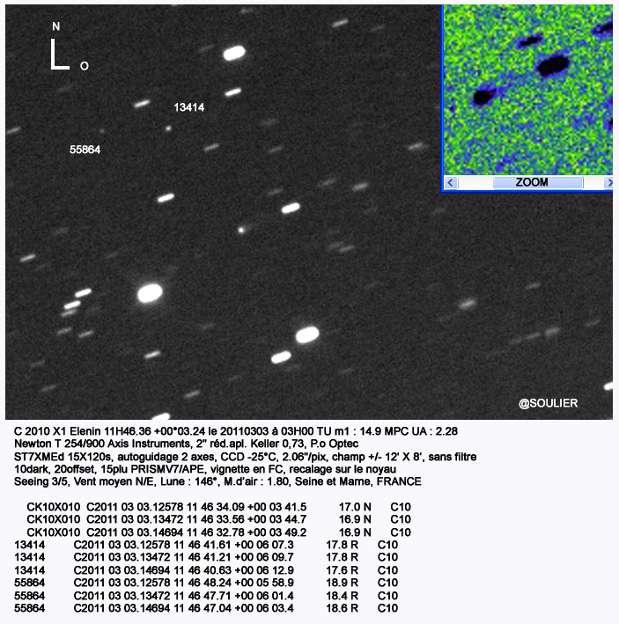
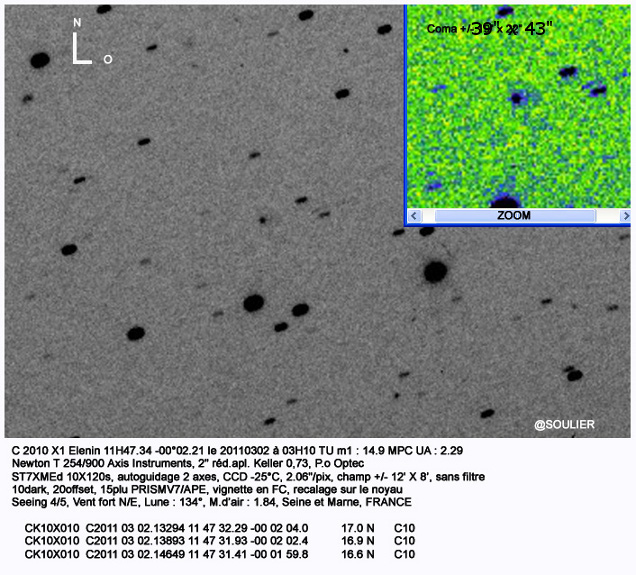


Diam. coma +/- 0.18' soit pour 2.94UA +/- 27938 km
Back to contents




















